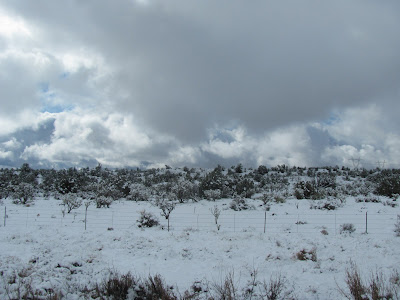A big front had passed the night before and dumped snow on all the mountain ranges (including the Mohaves, uphill from LHC). Driving through Kingman, we were dazzled by all the snow that had fallen there and in the Hualapais. Soon we came to signs saying "ROAD CLOSED" and we thought, they can't mean I-40? But they did, and as luck would have it, the interstate was closed just past our exit, highway 93.
 |
| Snowy desert near Kingman |
After a slow morning, it was a relief to bird a spot with even moderate bird activity. About 30 migrating Violet-green Swallows flew over in a stream, along with a few Trees; some typical riparian birds were active along the creek. It was certainly a surprise when a Golden-crowned Sparrow turned up with a handful of White-crowned Sparrows - a new state bird for David and a county bird for me! I've been checking sparrow flocks all winter looking for this species, so it was great to finally find one. This has been a very slow winter for Golden-crowned Sparrows in Arizona; the only report I know of was a few weeks ago in southeast AZ.
 |
| Photo by David Vander Pluym |
 |
| David enjoying the scenery at a randomly selected birding location |
 |
| Saguaro |
Our last stop of the day was along the Big Sandy River in the town of Wikieup. Driving along Cholla Canyon Ranch Rd, we were frustrated by a whole lot of "No Trespassing" signs, but finally found a way to access the river that seemed legitimate. Once we got into the habitat, we were floored. Extensive riparian habitat stretches for miles, with tall cottonwoods and patchy understory. This place seems golden. It wasn't long before we hit a flock, with more birds than we'd had most of the day. A harsh scolding call alerted us to a Plumbeous Vireo, rare in winter. Wandering through the sandy riverbed, we reached another area with budding cottonwoods and good bird activity. While David was checking out a tree full of Gila Woodpeckers and Audubon's Warblers, I stopped to scan the tops of another set of cottonwoods. While I scanned, I heard a faint call that I couldn't place. I figured it must be something really distant at first, but eventually I heard it clearly: a mournful, descending "wheeeeur" call that I know well. It was a Dusky-capped Flycatcher, calling softly but regularly. I called David over and we both listened to the calling bird. Unfortunately, it was in one of the few areas with a really thick understory, and a solid wall of tamarisk stood between us and the bird. That didn't stop us from trying to see it, and we crawled through tangles of tamarisk in a vain attempt to see the flycatcher. In the end, all we had to show for it were tamarisk needles everywhere.
Prior to this winter, there were only about five records of Dusky-capped Flycatcher in Arizona in winter. This winter, though, one turned up in Maricopa County, then the bird at Parker Oasis (La Paz County) was discovered, and now there is this one in Mohave County. In summer, this species is typically found in southeastern Arizona but does wander northwest of its typical range. Rosenberg et al. gives one record from Topock, but I know of no other sightings from Mohave County.
Needless to say, we were pretty satisfied with our day on the Big Sandy, even though we never got to see the Dusky-capped. More than anything, I am really excited to see what else may turn up in this spectacular area in the future!
No comments:
Post a Comment